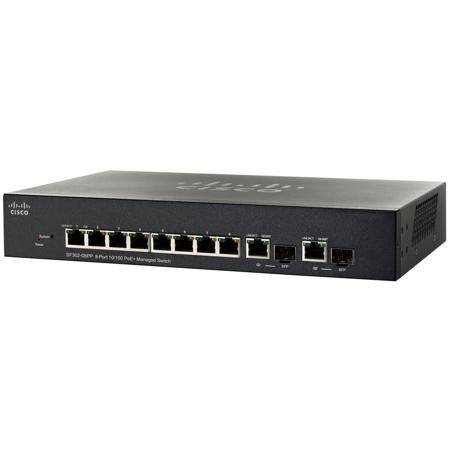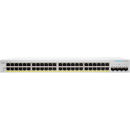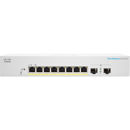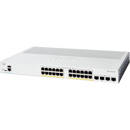
Cisco SF302-08PP-K9 8-Port 10/100 PoE+ Managed Switch with 62W Power Budget
SKU: CISF30208PPK
This item is no longer available.
Recommended Alternatives
Share:
Overview
Compare
Specs
Protection
Q&A
Questions & Answers
Reviews about this item
Review Summary
Cisco SF302-08PP-K9 Specifications
Spanning Tree Protocol (STP)
Standard 802.1d Spanning Tree support
Fast convergence using 802.1w (Rapid Spanning Tree [RSTP]), enabled by default
8 instances are supported
Multiple Spanning Tree instances using 802.1s (MSTP)Port Grouping
Support for IEEE 802.3ad Link Aggregation Control Protocol (LACP)
Up to 8 groups, Up to 8 ports per group with 16 candidate ports for each (dynamic) 802.3ad link aggregationVLAN
Support for up to 4096 VLANs simultaneously Port-based and 802.1Q tag-based VLANs MAC-based VLAN
Management VLAN
Private VLAN Edge (PVE), also known as protected ports, with multiple uplinks
Guest VLAN Unauthenticated VLAN
Dynamic VLAN assignment via Radius server along with 802.1x client authentication
CPE VLANVoice VLAN
Voice traffic is automatically assigned to a voice-specific VLAN and treated with appropriate levels of QoS
Auto voice capabilities deliver network-wide zero touch deployment of voice endpoints and call control devicesMulticast TV VLAN
Multicast TV VLAN allows the single multicast VLAN to be shared in the network while subscribers remain in separate VLANs (Also known as MVR)
Q-in-Q VLAN
VLANs transparently cross a service provider network while isolating traffic among customers
GVRP/GARP
Protocols for automatically propagating and configuring VLANs in a bridged domain
Unidirectional Link Detection (UDLD)
UDLD monitors physical connection to detect unidirectional links caused by incorrect wiring or cable/port faults to prevent forwarding loops and blackholing of traffic in switched networks
DHCP Relay at Layer 2
Relay of DHCP traffic to DHCP server in different VLAN. Works with DHCP Option 82
IGMP Versions 1, 2, and 3 Snooping
IGMP limits bandwidth-intensive multicast traffic to only the requesters
supports 1K multicast groups (source-specific multicasting is also supported)IGMP Querier
IGMP querier is used to support a Layer 2 multicast domain of snooping switches in the absence of a multicast router
Head-of-Line (HOL) Blocking
HOL blocking prevention
Jumbo Frames
Up to 9K (9216) bytes
IPv4 Routing
Wirespeed routing of IPv4 packets
Up to 512 static routes and up to 128 IP interfacesClassless Inter-Domain Routing (CIDR)
Support for CIDR
Layer 3 Interface
Configuration of layer 3 interface on physical port, LAG, VLAN interface or Loopback interface
DHCP relay at Layer 3
Relay of DHCP traffic across IP domains
User Datagram Protocol (UDP) Relay
Relay of broadcast information across Layer 3 domains for application discovery or relaying of BootP/DHCP packets
DHCP Server
Switch functions as an IPv4 DHCP Server serving IP addresses for multiple DHCP pools/scopes
Support for DHCP optionsSecure Shell (SSH) Protocol
SSH is a secure replacement for Telnet traffic. SCP also uses SSH. SSH v1 and v2 are supported
Secure Sockets Layer (SSL)
SSL support: Encrypts all HTTPS traffic, allowing highly secure access to the browser-based management GUI in the switch
IEEE 802.1X (Authenticator Role)
802.1X: RADIUS authentication and accounting, MD5 hash, Guest VLAN, Unauthenticated VLAN, Single/multiple host mode and single/multiple sessions
Supports time-based 802.1X Dynamic VLAN assignmentWeb Based Authentication
Web based authentication provides network admission control through web browser to any host devices and operating systems
STP Bridge Protocol Data Unit Guard
A security mechanism to protect the network from invalid configurations. A port enabled for BPDU Guard is shut down if a BPDU message is received on that port
STP Root Guard
This prevents edge devices not in the network administrator's control from becoming Spanning Tree Protocol root nodes
DHCP Snooping
Filters out DHCP messages with unregistered IP addresses and/or from unexpected or untrusted interfaces. This prevents rogue devices from behaving as a DHCP Server
IP Source Guard (IPSG)
When IP Source Guard is enabled at a port, the switch filters out IP packets received from the port if the source IP addresses of the packets have not been statically configured or dynamically learned from DHCP snooping. This prevents IP Address Spoofing
Dynamic ARP Inspection (DAI)
The switch discards ARP packets from a port if there is no static or dynamic IP/MAC bindings or if there is a discrepancy between the source or destination address in the ARP packet. This prevents man-in-the-middle attacks
IP/Mac/Port Binding (IPMB)
The features (DHCP Snooping, IP Source Guard, and Dynamic ARP Inspection) above work together to prevent DOS attacks in the network, thereby increasing network availability
Secure Core Technology (SCT)
Ensures that the switch will receive and process management and protocol traffic no matter how much traffic is received
Secure Sensitive Data (SSD)
A mechanism to manage sensitive data (such as passwords, keys, etc) securely on the switch, populating this data to other devices, and secure autoconfig. Access to view the sensitive data as plaintext or encrypted is provided according to the user configured access level and the access method of the user
Layer 2 Isolation PVE
PVE (also known as protected ports) provides Layer 2 isolation between devices in the same VLAN, supports multiple uplinks (with community VLAN)
Port Security
The ability to lock Source MAC addresses to ports, and limits the number of learned MAC addresses
RADIUS/TACACS+
Supports RADIUS and TACACS authentication. Switch functions as a client
Storm Control
Broadcast, multicast, and unknown unicast
RADIUS Accounting
The RADIUS accounting functions allow data to be sent at the start and end of services, indicating the amount of resources (such as time, packets, bytes, and so on) used during the session
DoS Prevention
Denial-of-Service (DOS) attack prevention
ACLs
Support for up to 512 rules
Drop or rate limit based on source and destination MAC, VLAN ID or IP address, protocol, port, differentiated services code point (DSCP)/IP precedence, TCP/UDP source and destination ports, 802.1p priority, Ethernet type, Internet Control Message Protocol (ICMP) packets, IGMP packets, TCP flag, Time-based ACLs supportedPriority Levels
4 hardware queues
Scheduling
Strict priority and weighted round-robin (WRR)
Queue assignment based on DSCP and class of service (802.1p/CoS)Class of Service
Port based
802.1p VLAN priority based
IPv4/v6 IP precedence/type of service (ToS)/DSCP based
Differentiated Services (DiffServ)
Classification and re-marking ACLs, trusted QoSRate Limiting
Ingress policer
Egress shaping and rate control
Per VLAN, per port, and flow basedCongestion Avoidance
A TCP congestion avoidance algorithm is required to minimize and prevent global TCP loss synchronization
Standards
IEEE 802.3 10BASE-T Ethernet, IEEE 802.3u 100BASE-TX Fast Ethernet, IEEE 802.3ab 1000BASE-T Gigabit Ethernet, IEEE 802.3ad LACP, IEEE 802.3z Gigabit Ethernet, IEEE 802.3x Flow Control, IEEE 802.1D (STP, GARP, and GVRP),IEEE 802.1Q/p VLAN, IEEE 802.1w RSTP, IEEE 802.1s Multiple STP, IEEE 802.1X Port Access Authentication, IEEE 802.3af, IEEE 802.3at, RFC 768, RFC 783, RFC 791, RFC 792, RFC 793, RFC 813, RFC 879, RFC 896, RFC 826, RFC 854, RFC 855, RFC 856, RFC 858, RFC 894
Standards (Cont.)
RFC 919, RFC 922, RFC 920, RFC 950, RFC 1042, RFC 1071, RFC 1123, RFC 1141, RFC 1155, RFC 1157, RFC 1350, RFC 1533, RFC 1541, RFC 1624, RFC 1700, RFC 1867, RFC 2030, RFC 2616, RFC 2131, RFC 2132, RFC 3164, RFC 3411, RFC 3412, RFC 3413, RFC 3414, RFC 3415, RFC 2576, RFC 4330, RFC 1213, RFC 1215, RFC 1286, RFC 1442, RFC 1451, RFC 1493, RFC 1573, RFC 1643, RFC 1757, RFC 1907, RFC 2011
Standards (Cont.)
RFC 919, RFC 922, RFC 920, RFC 950, RFC 1042, RFC 1071, RFC 1123, RFC 1141, RFC 1155, RFC 1157, RFC 1350, RFC 1533, RFC 1541, RFC 1624, RFC 1700, RFC 1867, RFC 2030, RFC 2616, RFC 2131, RFC 2132, RFC 3164, RFC 3411, RFC 3412, RFC 3413, RFC 3414, RFC 3415, RFC 2576, RFC 4330, RFC 1213, RFC 1215, RFC 1286, RFC 1442, RFC 1451, RFC 1493, RFC 1573, RFC 1643, RFC 1757, RFC 1907, RFC 2011
IPv6
IPv6 host mode
IPv6 over Ethernet Dual IPv6/IPv4 stack
IPv6 neighbor and router discovery (ND) IPv6 stateless address auto-configuration
Path maximum transmission unit (MTU) discovery
Duplicate address detection (DAD) ICMP version 6
IPv6 over IPv4 network with Intra-Site Automatic Tunnel Addressing Protocol (ISATAP) support
USGv6 and IPv6 Gold Logo certifiedIPv6 QoS
Prioritize IPv6 packets in hardware
IPv6 ACL
Drop or rate limit IPv6 packets in hardware
IPv6 First Hop Security
RA guard
ND inspection
DHCPv6 guard
Neighbor binding table (Snooping and static entries)
Neighbor binding integrity checkMulticast Listener Discovery Snooping
Deliver IPv6 multicast packets only to the required receivers (MLD v1/2)
IPv6 Applications
Web/SSL, Telnet server/SSH, ping, traceroute, Simple Network Time Protocol (SNTP), Trivial File Transfer Protocol (TFTP), SNMP, RADIUS, syslog, DNS client, Telnet Client, DHCP Client, DHCP Autoconfig, IPv6 DHCP Relay, TACACS
Web User Interface
Built-in switch configuration utility for easy browser-based device configuration (HTTP/HTTPS). Supports configuration, system dashboard, system maintenance, and monitoring
SNMP
SNMP versions 1, 2c, and 3 with support for traps, and SNMP version 3 user-based security model (USM)
Remote Monitoring (RMON)
Embedded RMON software agent supports 4 RMON groups (history, statistics, alarms, and events) for enhanced traffic management, monitoring, and analysis
IPv4 and IPv6 Dual Stack
Coexistence of both protocol stacks to ease migration
Firmware Upgrade
Web browser upgrade (HTTP/HTTPS) and TFTP and upgrade over SCP running over SSH
Upgrade can be initiated through console port as well
Dual images for resilient firmware upgradesPort Mirroring
Traffic on a port can be mirrored to another port for analysis with a network analyzer or RMON probe. Up to 8 source ports can be mirrored to one destination port. A single session is supported
VLAN Mirroring
Traffic from a VLAN can be mirrored to a port for analysis with a network analyzer or RMON probe. Up to 8 source VLANs can be mirrored to one destination port. A single session is supported
DHCP
DHCP Options facilitate tighter control from a central point (DHCP server) to obtain IP address, auto-configuration (with configuration file download), DHCP relay, and hostname (Options 12, 66, 67, 82, 129, and 150)
Secure Copy (SCP)
Securely transfer files to and from the switch
Autoconfiguration with SCP File Download
Enables secure mass deployment with protection of sensitive data
Text-Editable Config Files
Config files can be edited with a text editor and downloaded to another switch, facilitating easier mass deployment
Smartports
Simplified configuration of QoS and security capabilities
Auto Smartports
Applies the intelligence delivered through the Smartport roles and applies it automatically to the port based on the devices discovered over CDP or LLDP-MED. This facilitates zero touch deployments
Textview CLI
Scriptable command-line interface. A full CLI as well as a menu-based CLI is supported. User privilege levels 1, 7, and 15 is supported for the CLI
Cloud Services
Support for Cisco Small Business FindIT Network and Cisco OnPlus
Localization
Localization of GUI and documentation into multiple languages
Other Management
Traceroute
Single IP management
HTTP/HTTPS
SSH
RADIUS
Port mirroring
TFTP upgrade
DHCP client
BOOTP
SNTP
Xmodem upgrade
Cable diagnostics
Ping
Syslog
Telnet client (SSH secure support)Time-Based Port Operation
Link up or down based on user-defined schedule (when the port is administratively up)
Login Banner
Configurable multiple banners for web as well as CLI
Energy Detect
Automatically turns off power off on Gigabit Ethernet and 10/100 RJ-45 port when detecting link down
Active mode is resumed without loss of any packets when the switch detects the link upCable Length Detection
Adjusts the signal strength based on the cable length for Gigabit Ethernet models. Reduces the power consumption for cables shorter than 10m
Disable Port LEDs
LEDs can be manually turned off to save on Energy
MAC Table
Up to 16K (16384) MAC addresses
Bonjour
The switch advertises itself using the Bonjour protocol
Link Layer Discovery Protocol (802.1ab)
LLDP allows the switch to advertise its identification, configuration, and capabilities to neighboring devices that store the data in a MIB. LLDP-MED is an enhancement to LLDP that adds the extensions needed for IP phones (with LLDP-MED extensions)
Cisco Discovery Protocol (CDP)
The switch advertises itself using the Cisco Discovery Protocol. It also learns the connected device and its characteristics via CDP
Buttons
Reset button
Cabling Type
Unshielded twisted pair (UTP) Category 5 or better for 10BASE-T/100BASE-TX
UTP Category 5 Ethernet or better for 1000BASE-TLEDs
System, Link/Act, PoE, Speed, LED power saving option
Flash
16MB
CPU Memory
128MB
Certification
UL (UL 60950), CSA (CSA 22.2), CE mark, FCC Part 15 (CFR 47) Class A
Storage Temperature
-4 to 158 deg. F (-20 to 70 deg. C)
Operating Humidity
10% to 90%, relative, noncondensing
Storage Humidity
10% to 90%, relative, noncondensing
Minimum Requirements
Web browser: Mozilla Firefox version 8 or later; Microsoft Internet Explorer version 7 or later, Safari, Chrome
Category 5 Ethernet network cable
TCP/IP, network adapter, and network operating system (such as Microsoft Windows, Linux, or Mac OS X) installed on each computer in the networkFast Ethernet Ports
8 10/100 PoE+ ports with 62W power budget
2 combo mini-GBIC portsSwitching Capacity and Forwarding Rate
Capacity in Millions of Packets per Second (64-byte packets): 4.17Mpps
Switching Capacity in Gigabits per Second: 5.6GbpsPower Dedicated to PoE
62W (PoE+ supported)
Number of Ports Support PoE
8
Power Savings Mode
Energy Detect
System Power Consumption
110V=9.12W
220V=9.31WPower Consumption (with PoE)
110V=80.68W
220V=79.62WHeat Dissipation
271.67 BTU/hr
Total System Ports
8 Fast Ethernet + 2 Gigabit Ethernet
RJ-45 Ports
8 Fast Ethernet
Combo Ports (RJ-45 + SFP)
2 Gigabit Ethernet combo
Packet Buffer
8MB
Operating Temperature
32 to 113 deg. F (0 to 45 deg. C)
MTBF at 40deg. C (Hours)
899,905
Dimensions (WxHxD)
11 x 1.45 x 6.7" (279.40 x 36.83 x 170.18mm)
Weight
2.60 lbs (1.18kg)
UPC Code
882658594618
About Cisco SF302-08PP-K9
Easy-to-Use Managed Switches that Provide the Ideal Combination of Features and Affordability
To stay ahead in a competitive marketplace, small businesses need to make every dollar count. That means getting the most value from your technology investments, but it also means making sure that employees have fast, reliable access to the business tools and information they need. Every minute an employee waits for an unresponsive application - and every minute your network is down - has an impact on your bottom line. The importance of maintaining a strong and dependable business network only grows as your business adds more employees, applications and network complexity.
When your business needs advanced security and features but value is still a top consideration, you're ready for the new generation of Cisco Small Business managed switches: the Cisco 300 Series.
What's in the box:
- Cisco SF302-08PP-K9 8-Port 10/100 PoE+ Managed Switch
- Power Cord
- Mounting Kit
- Serial Cable
- CD-ROM with User Documentation (PDF)
- Quick Start Guide
- Cisco Lifetime Limited Warranty



